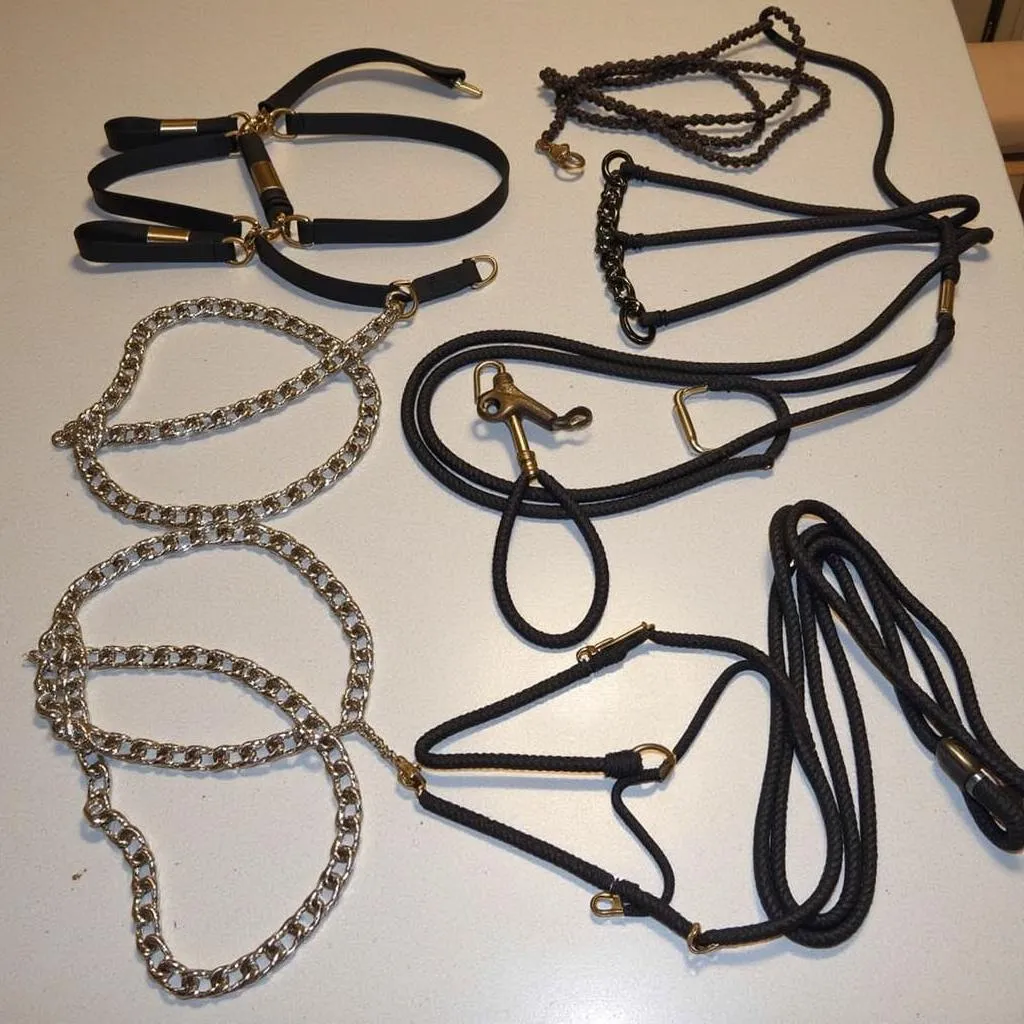A stud chain, also known as a lip chain, is a tool used in the horse world to gain control and enhance communication with a horse, particularly during handling or showing. It consists of a short chain with a handle, usually made of metal, designed to be placed over the horse’s upper lip. While seemingly simple, the use of a stud chain on a horse is a topic often met with debate and requires a thorough understanding of its purpose, proper use, and ethical considerations.
Purpose of Using a Stud Chain on a Horse
The primary function of a stud chain is to provide an additional point of control and enhance the effectiveness of cues given by the handler. When pressure is applied to the chain, it creates a concentrated sensation on the horse’s sensitive upper lip, encouraging the horse to respond by moving away from the pressure. This can be particularly helpful in situations where a horse might be resistant to other cues or require a higher level of responsiveness.
 Horse Wearing Stud Chain During Show
Horse Wearing Stud Chain During Show
Different Types of Stud Chains
Just as there are various bits for horses, stud chains also come in different styles, each with its own level of pressure and intended use.
- Flat Link Chain: This is the most common type, featuring flat links that lay relatively flat against the horse’s lip, offering a milder level of pressure.
- Twisted Link Chain: These chains have links that are twisted, creating a sharper pressure point when engaged. They are typically used for horses that are more resistant or require a stronger cue.
- Combination Chain: Some chains combine both flat and twisted links, offering varying levels of pressure depending on how the chain is held.
The choice of chain depends largely on the horse’s sensitivity, the handler’s experience, and the specific situation.
Proper Use of a Stud Chain: A Must for Horse Welfare
The key to using a stud chain responsibly lies in understanding that it is a tool of communication, not punishment.
- Gentle Pressure is Key: The chain should be used with intermittent and gentle pressure, releasing as soon as the horse responds to the cue.
- Timing is Everything: The timing of the pressure and release is crucial for effective communication.
- Consistency is Key: Using the chain consistently and fairly helps the horse understand the cues and respond appropriately.
 Horse Handler Holding Stud Chain Correctly
Horse Handler Holding Stud Chain Correctly
Ethical Considerations and Alternatives
While the stud chain can be an effective tool in the right hands, it’s crucial to acknowledge the ethical considerations surrounding its use. Misuse, such as yanking or jerking the chain, can cause pain and distress to the horse, leading to behavioral problems and potential injury.
There are alternatives to using a stud chain, such as:
- Rope Halter: Offers increased pressure points compared to a flat halter, providing clearer communication.
- Training with Positive Reinforcement: Focuses on rewarding desired behaviors, building a trusting relationship.
When is a Stud Chain Inappropriate?
A stud chain is not suitable for every horse or every situation. It should never be used on:
- Young or Untrained Horses: They lack the understanding and physical development to respond appropriately.
- Horses with Injuries: Using a chain on an injured horse can exacerbate the injury and cause further pain.
 Different Horse Training Tools Including Stud Chain
Different Horse Training Tools Including Stud Chain
Conclusion
The stud chain can be a valuable tool for experienced horse handlers when used correctly and ethically. However, it’s not a shortcut to control and should always be approached with careful consideration for the horse’s well-being. If you’re considering using a stud chain, it’s essential to seek guidance from a qualified equine professional who can provide instruction on proper use and help you determine if it’s the right choice for your horse.
Remember, building a trusting and respectful relationship with your horse should always be the priority.
Frequently Asked Questions about Stud Chains on Horses
- Is a stud chain cruel? When used correctly, a stud chain is not inherently cruel. However, misuse can cause pain and distress.
- Can I use a stud chain on a young horse? It’s not recommended to use a stud chain on young or untrained horses.
- What are the alternatives to using a stud chain? Rope halters and training with positive reinforcement are viable alternatives.
- How do I know if a stud chain is right for my horse? Consulting with a qualified equine professional is crucial to determine if a stud chain is appropriate.
Need help with horse care or training? Contact Justus Horses USA today!
Phone: 0772127271
Email: justushorses@gmail.com
Location: QGM2+WX2, Vị Trung, Vị Thuỷ, Hậu Giang, Việt Nam
Our team is available 24/7 to assist you!